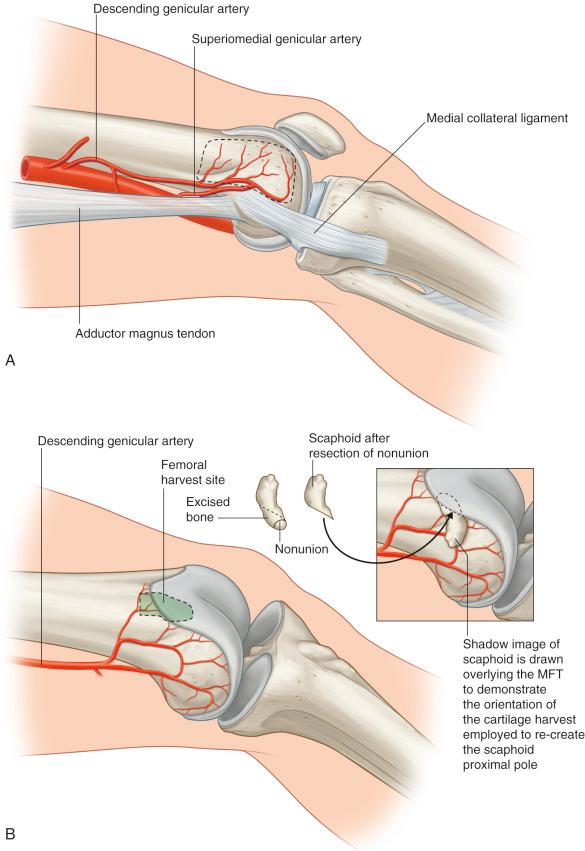Physical Address
304 North Cardinal St.
Dorchester Center, MA 02124
Increasing knowledge of the blood supply to the distal femur has resulted in the development of a variety of composite flaps designed to include bone from the medial femoral condyle. Flaps from this area can be designed to include not only bone but also articular cartilage, skin, muscle, and tendon. The original description of a periosteal flap from this region was described by Masquelet in 1988 and was based on the descending geniculate artery. This flap was then modified by Doi to include the periosteum and femoral cortex for the management of scaphoid non-unions. Recent publications have shown the medial geniculate arterial system also supplies the surrounding skin, articular cartilage, muscle, and tendon allowing for the creation of composite vascularized bone flaps. This variation in tissue types, in addition to a relatively small donor site, has allowed this flap to gain a newfound popularity for the management of composite bony defects within the extremities as well as the head and neck as its donor site may compare favorably with that of the fibula or iliac crest bone flaps.
The flaps of the medial femoral condyle (MFC) are based on the geniculate arterial system, which is a branch of the femoral artery and is located medially in the thigh and knee.

The anatomy of the MFC flap has been studied extensively and most recently by Yamamoto and Iorio and colleagues. The bone flap is located over the medial femoral condyle and is bound by three borders, the posterior border of the femur, anteriorly by the medial patellar facet, and distally by the medial collateral ligament. The flap is supplied by two sources: the descending genicular artery (DGA) and the superomedial genicular artery (SGA). The DGA originates from the femoral artery just distal to the adductor hiatus. It lies deep or lateral to the adductor magnus tendon along the posterior aspect of the medial intermuscular septum. The DGA typically has three branches, including an articular branch, a muscular branch, and a saphenous branch. The articular branch feeds the periosteum and the articular cartilage on the superior femoral condyle. The muscular branch supplies the vastus medialis muscle and the saphenous branch supplies the subcutaneous tissue and overlying skin.
Yamamoto and colleagues studied the arterial anatomy to the medal femoral condyle in 19 cadavers. They discovered the DGA was present in 89% of the specimens with the artery originating on average 13.7 cm from the articular surface of the knee. At its origin the vessel had an average internal diameter of 1.5 mm (range 1–2 mm). An osteoarticular branch was present in 89% of specimens branching from the DGA approximately 11.3 cm (range 5.5–15 cm) from the knee joint and this branch had an average internal diameter of 1.1 mm (range 0.63–1.5 mm); 79% of specimens had an identifiable saphenous branch, which travels with the saphenous nerve and perfuses the overlying skin.
The SGA originates from the proximal portion of the popliteal artery. In Yamamoto's anatomic study, this vessel was present in 100% of the specimens with the origin of the vessel just 5.2 cm from the articular surface. The vessel has an average internal diameter of 0.78 mm at its origin and ranged in diameter at 0.38–1.4 mm. The vessel crosses from behind the adductor magnus tendon to anastomose with the osteoarticular branch of the DGA contributing to the perforating vessels over the condyle. The superior medial genicular artery was the dominant vessel supplying the medial femoral condyle in two of the specimens in Yamamoto's study ( Fig. 55.2 ).
Additional pertinent anatomic points about the flap include:
The preferred vascular supply to the flap is the DGA, as it has a longer pedicle length (between 5 and 10 cm), and larger internal diameter than the SGA, facilitating microvascular anastomosis.
The DGA divides into three arteries: the muscular branch, the articular branch, and the saphenous branch.
The articular branch divides into the upper transverse artery (UTA) and the central longitudinal artery (CLA):
The UTA gives off four branches: ascending, posterior descending, middle descending, and anterior descending branches
The CLA divides into the posterior (arcuate) and anterior branch.
The middle branch of the UTA and the anterior branch of the CLA anastomose to form the main anastomotic arch of the medial femoral condyle.
descending geniculate artery (DGA)
Distance from the medial knee joint line: 15.4 cm (11.3–20.8 cm)
Diameter: 1.5 mm (1–2 mm)
Length: 1.2 cm (0.3–3 cm)
The descending geniculate artery is absent or diminutive in 10–15%.
superior medial geniculate artery (SMGA)
Distance from the medial knee joint line: 7.5 cm (4.7–9 cm)
Diameter: 0.75 mm (0.29–1.3 mm)
Distance from the medial knee joint line: 12 cm (8–18 cm)
Diameter: 1.4 mm (0.5–3 mm)
Length: 6.3 cm (5–7 cm)
Distance from the medial knee joint line: 12.5 cm (10–17.5 cm)
Diameter: 1.2 mm (0.5–1.8 mm)
Length: 11.4 cm (6.5–14 cm)
Distance from the medial knee joint line: 13 cm (9–17.5 cm)
Diameter: 1.3 mm (0.4–2 mm)
Length: 13.7 cm (10.5–16 cm)
Distance from the medial knee joint line: 7.2 cm (5.4–8.9 cm)
Diameter: 0.55 mm (0.38–0.70 mm)
Distance from the UTA takeoff of the descending genicular artery: 2.7 cm (1.4–7 cm)
Diameter: 0.28 mm (0.21–0.29 mm)
Distance from the UTA takeoff of the descending genicular artery: 0.96 cm (0.3–1.6 cm)
Diameter: 0.33 mm (0.18–0.41 mm)
Length from the UTA takeoff of the descending genicular artery: 3.4 cm (1.7–5.3 cm)
Diameter: 0.49 mm (0.31–0.67 mm)
Distance from the CLA origin of the descending genicular artery: 1.98 cm (0.4–4.1 cm)
Distance from the CLA origin of the descending genicular artery: 2.59 cm (0.8–4.65 cm)
Angiosome area: 70 cm 2
Angiosome area: 361 cm 2
Become a Clinical Tree membership for Full access and enjoy Unlimited articles
If you are a member. Log in here